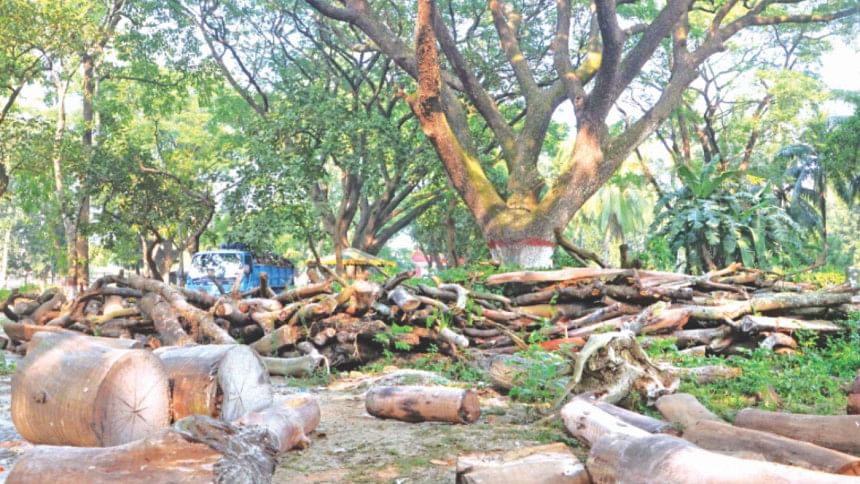A misplaced focus

Rajshahi Zoo was once a prime recreation facility for city-dwellers and visitors. But since the city corporation took responsibility for its management in 1996, the zoo's grounds have steadily dwindled in size. The latest move pits science against science, with a planetarium to be constructed on the zoo's land. The development will leave both the zoo's visitors and animals with little room to move.
Originally, the zoo was spacious. It was established from 1972, on 82 bighas of land, which in the British era had been a racecourse.
Until 2003, its western edge featured a 16-bigha deer enclosure where at least 350 deer lived. Along the eastern boundary were roomy cages for monkeys, baboons and chimpanzees. Between them were lions, tigers, hyenas, bears, snakes and birds; along with displays of domesticated animals. All of the animals were housed in amply-sized enclosures.
“We could hardly see the whole zoo in a single day,” recalls one local, Murad Parvez, who knew the zoo when it was in prime condition.
In more recent years, Rajshahi City Corporation has pursued a series of development projects on the land. Projects valued at Tk 23 crore have been approved since 2010.
Then, in February 2016, a further six bighas was offered on a long-term lease to the science and technology ministry as the site for the country's second Novo Theatre planetarium, a Tk 226 crore project. The Public Works Department is slated to commence the facility's year-long construction this month.
The PWD also published an advertisement in some national dailies inviting bids for tender in this regard.
Curiously, the land value assigned by the land ministry, in lease documents dated May 11, 2016, is the paltry sum of Tk 1,000.
Rajshahi Zoo, which once had a rich collection of animals, is in a sorry state. Some of the animals, including lions, tigers, hyenas and civets, have died over the years, due to neglect, accidents and loneliness.
With a view to reducing maintenance costs meanwhile, the size of the deer herd was reduced to 54, with their enclosure now covering three bighas.
Currently what is left of the rest of the zoo is squeezed into 13 bighas, with the remainder of the land having been redeveloped into a children's park, picnic areas, roads, restaurants and offices.
“The zoo is so small now that it barely takes an hour to see it,” says Murad Parvez. “The zoo has been painted into a corner.”
Moreover, where once the animals took benefit from a large number of shelter trees, their new enclosures are under the open sky. “The animals will face hard days during the heat of summer and biting cold in winter,” notes Ahmed Shafiuddin, the local president of Shushashoner Jannoy Nagorik (SHUJAN). Prof ABM Mohsin from the fisheries department of Rajshahi University agrees the animals will suffer. “The more their space is reduced, the more difficult the situation will be for them,” he says. “Life in captivity isn't easy for zoo animals.”
He believes that visitor numbers to the zoo are bound to decline since few will take pleasure from seeing animals in distress.
During a visit to the zoo recently, The Daily Star observed a number of large trees that must be several decades old, some in piles, others still standing, on the proposed planetarium site.
“The chopped trees were either dead or fell in storms,” said the zoo in-charge, Farhad Uddin. “More than a hundred healthy trees will be felled when construction begins.”
Rajshahi City Corporation Chief Engineer Ashraful Haque admits the development will affect the animals and the natural environment. “There will be some damage,” he says. “But we are doing all we can to make the place economically viable.”
According to Haque, the zoo's daily income was around Tk 3,000 per day until the first major overhaul in 2008, it then rose to around Tk 30,000 per day. “In the 2015-16 fiscal year, the zoo earned Tk 3.6 crore after spending Tk 80 lakh,” he said, “and visitors to the planetarium will also pay for zoo entry.” Ahmed Shafiuddin, the local president of SHUJAN, said, “It's ironic that both the zoo and the planetarium share a similar goal: to raise public awareness of the universe in which we live. In Rajshahi, it seems, awareness of the distant stars is to be prioritised over that of some of the species with which we share planet Earth.”


 For all latest news, follow The Daily Star's Google News channel.
For all latest news, follow The Daily Star's Google News channel. 



Comments